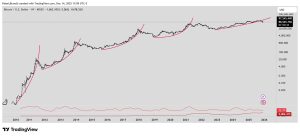Yesterday, the Governor of the Fed, Jerome Powell, announced the start of tapering, triggering some volatility in equity markets and Bitcoin.
How will tapering work
Indeed, he said he will start reducing the monthly pace of his asset purchases by an amount of $15 billion.
Starting at the end of November, purchases will be $105 billion a month, down from the current $120 billion, and starting in December it will drop to $90 billion.
The plan would be to continue to reduce purchases by $15 billion each month until the programme ends in the middle of next year.
At the end of November, the reduction will be 12% of what has been done so far, while in December it will be 25%.
The Fed has also indicated that it is prepared to adjust the pace of asset purchases again if the economic outlook changes.
These asset purchases are in fact a form of financial stimulus based on the creation of new money, i.e. the result of an expansionary monetary policy commonly known as “Quantitative Easing” or QE. As a result of this expansionary monetary policy, the Fed’s balance sheet has practically doubled since March 2020, when this new QE began.

Fed policies and tapering, the effects on Bitcoin
In the past, QE by central banks seems to have always had an impact on the price of Bitcoin, since BTC’s monetary policy by contrast is deflationary in nature. It is possible that even the bullrun that started in November 2020 was somehow fuelled by these huge money inflows into the financial markets.
Taking the S&P 500 Index as a reference, it is precisely since the end of March 2020 that a massive bull run began and is still continuing to make new all-time highs, with an overall increase of 109% since the low in March 2020, and 79% since April 2020.
For Bitcoin, the growth has been far greater, but it did not start in March 2020, when it simply recovered its losses and then lateralized until early October.
In other words, while the S&P 500’s bullrun seems to be directly linked to the Fed’s monetary stimulus, it seems clear that there was more to Bitcoin’s bullrun than that. Most likely this is the effect of the halving, as it was very similar to the previous two halvings.
Probably the parameter to watch out for is inflation, which is still very high and not likely to fall much any time soon. For this reason, it is unlikely that the Fed’s change in monetary policy will have any impact on the price of Bitcoin in the coming weeks, or months. It will be different when, and if, inflation starts to fall significantly.
Yesterday, while Powell announced the monetary policy update, the US stock market indices shot up, while Bitcoin experienced considerable volatility but essentially stayed within the range of the last few days, between $61,000 and $63,500.
The fact that yesterday’s crypto markets did not seem to be spooked at all by the Fed’s change of course suggests that the impact could be minimal in the near future too, unless there are any surprises from the inflation data.
The post Fed, tapering begins: effects on Bitcoin appeared first on The Cryptonomist.























